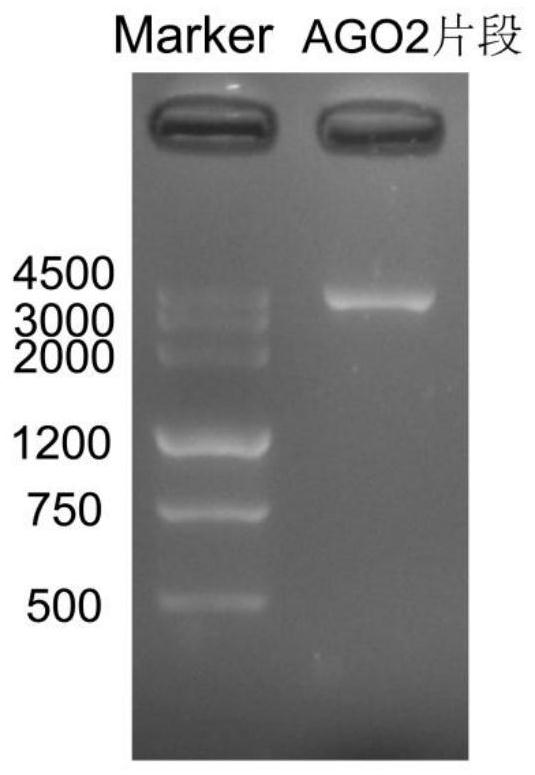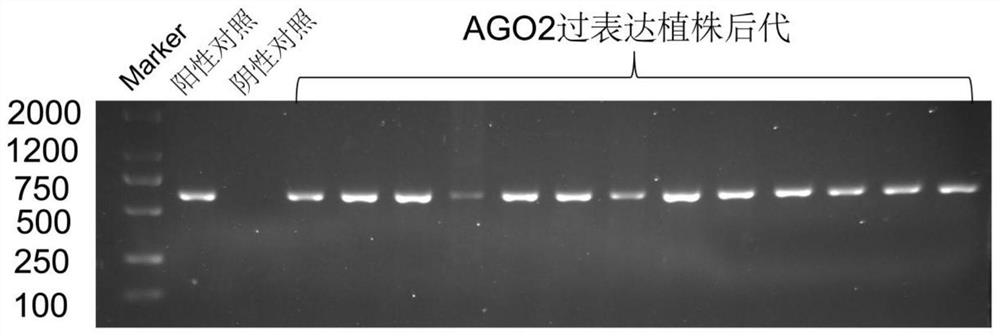A protein related to rice yield and its coding gene and application
A rice and gene technology, applied in the field of genetic engineering, can solve the problems that have not existed, and achieve the effect of increasing the yield and reducing the area of arable land.
- Summary
- Abstract
- Description
- Claims
- Application Information
AI Technical Summary
Problems solved by technology
Method used
Image
Examples
Embodiment 1
[0041] The cloning of embodiment 1 OsAGO2 gene, the construction of overexpression vector
[0042] Take the seedling leaf parts of rice variety ZH11, use TriZolReagent (Invitrogen Company, its article number: 15596026) to extract the total RNA of the leaves, and use a UV spectrophotometer to detect the purity and concentration of the extracted total RNA, and take 1 μg of total RNA as the initial For the reverse transcription reaction, the reverse transcriptase used is AMV (TAKARA Company), and the steps of the reverse transcription reaction refer to the instructions for use of the reverse transcriptase. Using the reverse transcription product as a template, primers are designed according to the cDNA sequence of the gene provided by NCBI (http: / / www.ncbi.nlm.nih.gov / ), and the primer sequence is as follows: (3-3475bp)
[0043] SEQ ID NO: 3
[0044] AGO2F:aaaaACTAGTaatcgaaacgtcgttctgatcg
[0045] SEQ ID NO: 4
[0046] AGO2R:aaaaACTAGTgctgtcgtcagatgaagaac
[0047] PCR amplifi...
Embodiment 2
[0053] Example 2 The AGO2 overexpression vector was transferred into the callus of normal japonica rice variety Zhonghua 11 by using the genetic transformation method mediated by Agrobacterium EHA105.
[0054] The transformation method is described in the following literature: Zhou Lingyan, Jiang Dagang, Wu Hao et al., Establishment of a rice transformation system based on TAC vector. Acta Genetica Sinica, 2005, 32: 514-518. After screening, pre-differentiation, and differentiation, 5 transformed plants of the T0 generation were obtained. The T0 generation was detected by PCR and quantitative PCR, and the positive transformed plants were identified from the DNA level and the RNA level.
[0055] image 3 , after PCR identification, all were positive, and the PCR primer sequences were as follows:
[0056] SEQ ID NO: 7
[0057] Primer 1: 5'-GACAGCGTCTCCGACCTGAT-3';
[0058] SEQ ID NO: 8
[0059] Primer 2: 5'-CATCGCCTCGCTCCAGTCAAT-3';
[0060] The PCR amplification conditions...
Embodiment 3
[0062] Example 3. Identification of Yield Traits of OsAGO2, Os04g0615700 Overexpression Transgenic Plants
[0063] The transgenic plants identified as positive by PCR were cultivated to maturity, and the plant morphology in different periods was observed. The results were as follows: Figures 5a-5e As shown, the obtained transgenic plants of the three homozygous lines (OsAGO2-1, OsAGO2-2, OsAGO2-3) all showed a phenotype of significantly increased grain number per panicle. Compared with the control plants, the transformed plants had obvious changes in the following four yield traits: increased 100-grain weight; increased grain number in the main panicle; increased grain length (Fig. 5d); and increased yield per plant. Figure 6 Shown are 2 transgenic OsAGO2 plants and 1 control plant.
PUM
 Login to View More
Login to View More Abstract
Description
Claims
Application Information
 Login to View More
Login to View More - R&D Engineer
- R&D Manager
- IP Professional
- Industry Leading Data Capabilities
- Powerful AI technology
- Patent DNA Extraction
Browse by: Latest US Patents, China's latest patents, Technical Efficacy Thesaurus, Application Domain, Technology Topic, Popular Technical Reports.
© 2024 PatSnap. All rights reserved.Legal|Privacy policy|Modern Slavery Act Transparency Statement|Sitemap|About US| Contact US: help@patsnap.com










